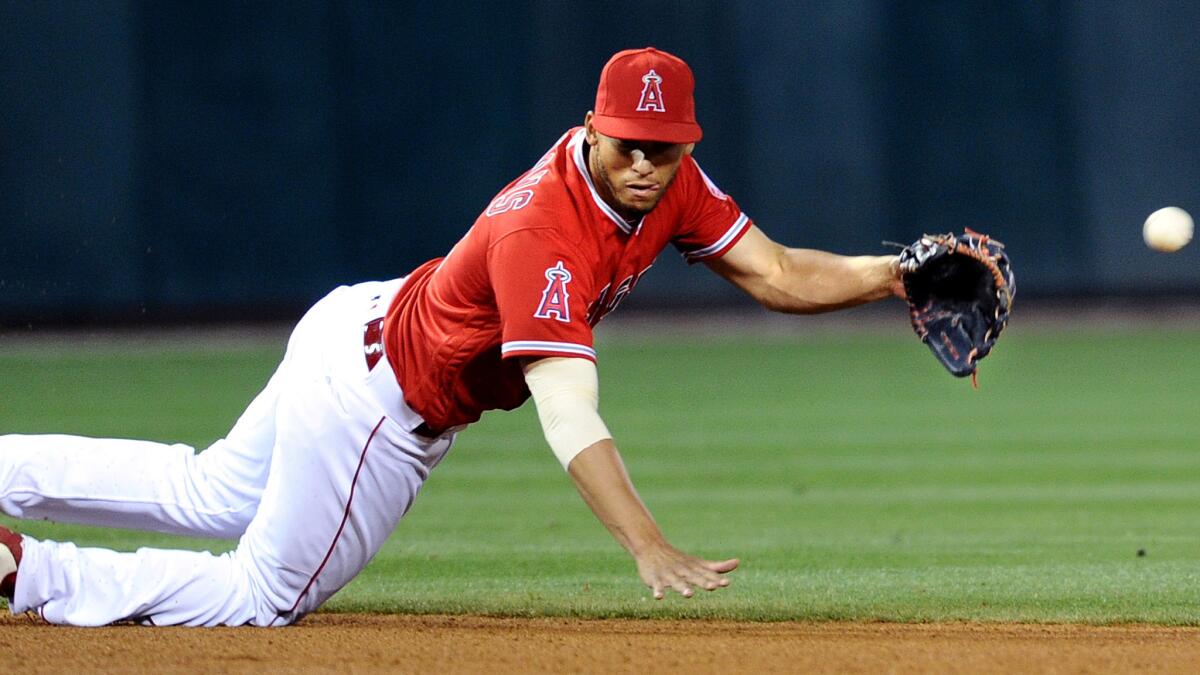Frequent shifting has not paid off so far for the Los Angeles Angels

Angels shortstop Andrelton Simmons dives for a ball hit by the Cubs’ Jorge Soler during a game April 4.
- Share via
The Angels are shifting their infielders more than ever before and more than any other team. They’re also not yet succeeding with those shifts, prompting discussion this week about what will happen next.
The 139 times batters have put the ball into play against the Angels’ shift in 2016, they are batting .302 with a .384 slugging percentage, according to Fangraphs.com. The 89 times hitters have put the ball into play when the Angels are not in a shift, they are hitting .202 with a .250 slugging percentage.
It is a significant gap, but it is not a statistically significant sample, far too small to draw real conclusions. But it’s what exists now, and it’s interesting. There are additional considerations too as Manager Mike Scioscia noted this week in listing the limits of the data supporting shifts.
“What those sheets do not have built in them is a hitter’s ability to adjust to them,” he said. “They are not future projections. We’ve seen hitters who have the ability to augment their swings and have done it and been successful. That’s what you are compiling now, to see what adjustments you have to make.”
In 2015, per Fangraphs.com, Angels opponents hit .284 with a .359 slugging mark when they were not shifted, .292 with .420 slugging when they were. In 2014, the numbers were about even. But the site’s shift numbers have the Angels shifting 15 times a game this season. Four seasons ago, they averaged one a game, and last year only four.
“It’s definitely a lot more than I’m used to,” said shortstop Andrelton Simmons, acquired from the Atlanta Braves in the off-season. “The thing I like is we’re communicating on the shift. It’s not just because the chart says so. We’ve been feeling more comfortable with it as we’ve gone on.”
There have been apparent missteps. Notably, the Angels did not shift against Chicago Cubs first baseman Anthony Rizzo in the first inning on opening day. He singled up the middle, where they would’ve had a defender in a shift. In Rizzo’s remaining at-bats, they shifted.
Asked about the club’s league-leading rate so far this season, Scioscia said that the front office is not insisting that the Angels shift more often than any other team.
“We’re going to continue to do what makes sense,” he said.
Simmons going right
Late last month, Simmons heard a former teammate’s teasing that hit right where it hurt.
The Angels were playing the San Diego Padres in a spring game and Padres catcher Christian Bethancourt, once a top Braves prospect, noticed that Simmons had lined three consecutive drives to the opposite field. So, he asked his friend when he’d started hitting the ball the other way, to which Simmons had no rejoinder.
It’s a new development. Through his first three-plus seasons, the shortstop had become known as a classic pull hitter. He was once a power threat — he hit 17 home runs in 2013 — but has regressed since and Angels hitting coach Dave Hansen tried during spring training to stop Simmons from “getting so pull-oriented.” What Bethancourt saw showed that Simmons had listened.
“I worked on going to right before,” Simmons said, “but I never really mastered or got that good at actually doing it.”
Simmons, 26, has struck out once in 34 plate appearances and has not walked. He puts essentially everything into play.
“Most of the time, I laugh when I strike out,” he said. “I’m so used to making contact that whenever I strike out I’m like, ‘Whoa, OK.’ Maybe I should swing harder, because I can strike out more often. Maybe I should hack sometimes. I do take big swings every once in a while.”
Spray-chart data is only available from the season’s first week. In that week, Simmons hit more balls to the right side of the field than the left.
“This year, I’m a different hitter,” he said. “I feel like I’m better at commanding, going the other way, on my own will. It’s not that I do it every single time, but I feel more comfortable.”
Follow Pedro Moura on Twitter: @pedromoura
More to Read
Go beyond the scoreboard
Get the latest on L.A.'s teams in the daily Sports Report newsletter.
You may occasionally receive promotional content from the Los Angeles Times.








